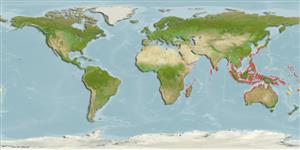Gastropoda |
Not assigned |
Cerithiidae
Environment: milieu / climate zone / depth range / distribution range
Ecology
Benthic; depth range 0 - 2 m (Ref. 101213). Tropical
Indo-West Pacific.
Length at first maturity / Size / Weight / Age
Maturity: Lm ? range ? - ? cm Max length : 5.0 cm SHL male/unsexed; (Ref. 349); common length : 3.0 cm SHL male/unsexed; (Ref. 349)
Often collected for food together with Potamididae, and sold with them in the local markets (Ref. 349). Found in mud flats. Commonly associated with various Potamididae such as Cerithidea cingulata (Gmelin). May occur in very dense populations. Occurs at the mid tide mark (Ref. 349).
Life cycle and mating behavior
Maturity | Reproduction | Spawning | Eggs | Fecundity | Larvae
Members of the order Neotaenioglossa are mostly gonochoric and broadcast spawners. Life cycle: Embryos develop into planktonic trocophore larvae and later into juvenile veligers before becoming fully grown adults.
Poutiers, J.M. 1998 Gastropods. p. 363-648. In Carpenter, K. E. and V. H. Niem. 1998. FAO species identification guide for fishery purposes. The living marine resources of the Western Central Pacific. Volume 1. Seaweeds, corals, bivalves, and gastropods. Rome, FAO. (Ref. 349)
IUCN Red List Status
(Ref. 130435: Version 2025-1)
CITES status (Ref. 108899)
Not Evaluated
Not Evaluated
Threat to humans
Harmless
Human uses
Fisheries: commercial
| FishSource |
Tools
More information
Trophic EcologyFood items (preys)
Diet composition
Food consumption
Predators
Population dynamicsGrowthMax. ages / sizesLength-weight rel.Length-length rel.Length-frequenciesMass conversionAbundance Life cycleReproductionMaturityFecunditySpawningEggsEgg developmentLarvae PhysiologyOxygen consumption
Human RelatedStamps, coins, misc.
Internet sources
Estimates based on models
Preferred temperature
(Ref.
115969): 24.6 - 29.3, mean 28.6 (based on 2374 cells).
Fishing Vulnerability
Low vulnerability (10 of 100).
Price category
Unknown.
